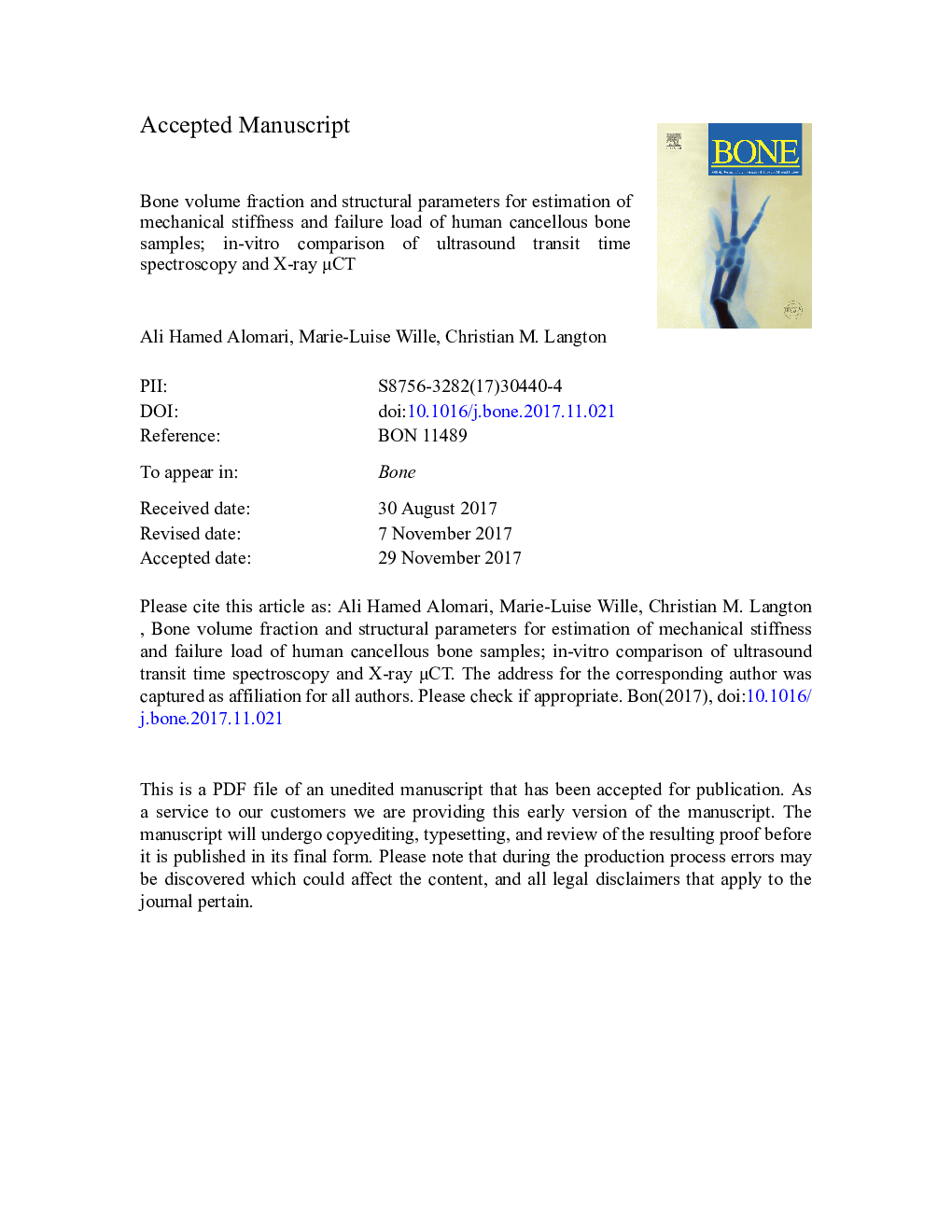| کد مقاله | کد نشریه | سال انتشار | مقاله انگلیسی | نسخه تمام متن |
|---|---|---|---|---|
| 8625201 | 1568112 | 2018 | 27 صفحه PDF | دانلود رایگان |
عنوان انگلیسی مقاله ISI
Bone volume fraction and structural parameters for estimation of mechanical stiffness and failure load of human cancellous bone samples; in-vitro comparison of ultrasound transit time spectroscopy and X-ray μCT
دانلود مقاله + سفارش ترجمه
دانلود مقاله ISI انگلیسی
رایگان برای ایرانیان
کلمات کلیدی
موضوعات مرتبط
علوم زیستی و بیوفناوری
بیوشیمی، ژنتیک و زیست شناسی مولکولی
زیست شناسی تکاملی
پیش نمایش صفحه اول مقاله

چکیده انگلیسی
Conventional mechanical testing is the 'gold standard' for assessing the stiffness (N mmâ 1) and strength (MPa) of bone, although it is not applicable in-vivo since it is inherently invasive and destructive. The mechanical integrity of a bone is determined by its quantity and quality; being related primarily to bone density and structure respectively. Several non-destructive, non-invasive, in-vivo techniques have been developed and clinically implemented to estimate bone density, both areal (dual-energy X-ray absorptiometry (DXA)) and volumetric (quantitative computed tomography (QCT)). Quantitative ultrasound (QUS) parameters of velocity and attenuation are dependent upon both bone quantity and bone quality, although it has not been possible to date to transpose one particular QUS parameter into separate estimates of quantity and quality. It has recently been shown that ultrasound transit time spectroscopy (UTTS) may provide an accurate estimate of bone density and hence quantity. We hypothesised that UTTS also has the potential to provide an estimate of bone structure and hence quality. In this in-vitro study, 16 human femoral bone samples were tested utilising three techniques; UTTS, micro computed tomography (μCT), and mechanical testing. UTTS was utilised to estimate bone volume fraction (BV/TV) and two novel structural parameters, inter-quartile range of the derived transit time (UTTS-IQR) and the transit time of maximum proportion of sonic-rays (TTMP). μCT was utilised to derive BV/TV along with several bone structure parameters. A destructive mechanical test was utilised to measure the stiffness and strength (failure load) of the bone samples. BV/TV was calculated from the derived transit time spectrum (TTS); the correlation coefficient (R2) with μCT-BV/TV was 0.885. For predicting mechanical stiffness and strength, BV/TV derived by both μCT and UTTS provided the strongest correlation with mechanical stiffness (R2 = 0.567 and 0.618 respectively) and mechanical strength (R2 = 0.747 and 0.736 respectively). When respective structural parameters were incorporated to BV/TV, multiple regression analysis indicated that none of the μCT histomorphometric parameters could improve the prediction of mechanical stiffness and strength, while for UTTS, adding TTMP to BV/TV increased the prediction of mechanical stiffness to R2 = 0.711 and strength to R2 = 0.827. It is therefore envisaged that UTTS may have the ability to estimate BV/TV along with providing an improved prediction of osteoporotic fracture risk, within routine clinical practice in the future.
ناشر
Database: Elsevier - ScienceDirect (ساینس دایرکت)
Journal: Bone - Volume 107, February 2018, Pages 145-153
Journal: Bone - Volume 107, February 2018, Pages 145-153
نویسندگان
Ali Hamed Alomari, Marie-Luise Wille, Christian M. Langton,